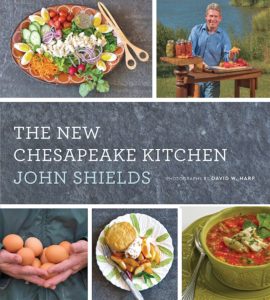 John Shields (MrcrabcakeJohn) is the owner of Gertrude’s Chesapeake Kitchen in the art museum in Baltimore, a PBS food show host, the author of many cookbooks, and an advocate of the cuisine (and waterways) of the Chesapeake region. His books generally focus on 18th, 19th, and 20’s century dishes and styles of cooking from the Chesapeake region. His latest book, however, The New Chesapeake Kitchen focuses on current recipes, since the bay has changed much in recent years.
John Shields (MrcrabcakeJohn) is the owner of Gertrude’s Chesapeake Kitchen in the art museum in Baltimore, a PBS food show host, the author of many cookbooks, and an advocate of the cuisine (and waterways) of the Chesapeake region. His books generally focus on 18th, 19th, and 20’s century dishes and styles of cooking from the Chesapeake region. His latest book, however, The New Chesapeake Kitchen focuses on current recipes, since the bay has changed much in recent years.
We LOVE John Shields and have written about him many times, so were happy to have a nice phone conversation from him. Some of the highlights are below:
When asked how Chesapeake area cuisine has changed in recent years:
JS: There is a return to looking for and using fresh, local ingredients (including shopping at farmer’s markets), which includes being mindful of seasonality. We have less crabs and native oysters than in the past, but now have new local cheeses, wines, and beers, high quality farm-raised oysters (raised from when they are teeny in floats and don’t have the antibiotics and chemicals of other aquatic farming), and even tasty invasive species fish (blue catfish).
Regional cuisines are ever-evolving. I focused on the people of the region, and what they are cooking, and found some wonderful ethnic influences in their dishes. Some examples in the book include Caribbean Vegetable Stew, Moroccan Chickpea Vegetable Tagine, African-Inspired Sweet Potato & Peanut Soup, Mama Lan’s Tangy Noodles (which works with any protein), and Emily’s Hungarian Brisket.
John is a master of the crab cake, but also makes them with other main ingredients. This came up when we were talking about invasive species fish. He even has a vegetarian recipe for “mock” crab cakes in the book.
JS: We serve make Blue Catfish Cakes (catties) at the restaurant for brunch. Blue catfish is an invasive fish that eats baby oysters and blue crabs, so by eating it, we are eating a delicious fish (that does not taste “muddy” like some catfish), and also helping maintain the health of the bay.
John talked often about recipes that stretch proteins and are “plant forward,” so you can feed more people affordably. This book features recipes such as Frogmore Stew, Wild Shrimp & Sweet Corn Chowder, Aunt Bessie’s Crab Pudding, and Asparagus & Crab Tart, that do just that.
He recommends using underused fish such as hake, croaker, white or yellow perch, spot, and crappie, since they are more available than they used to be (unless you have a fishing rod). We have some wonderful protein sources in the Chesapeake region, and should use them.
-JAY

